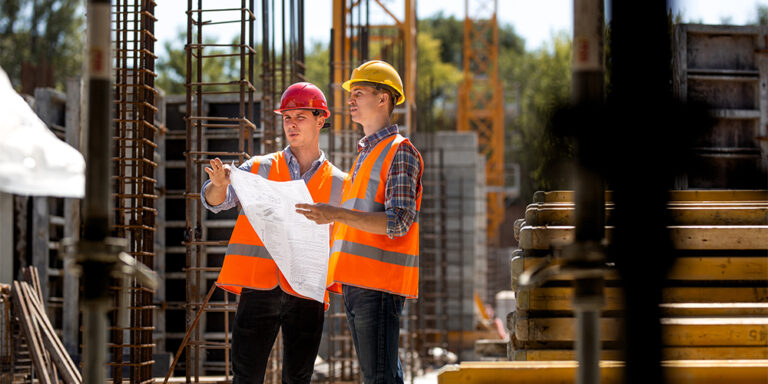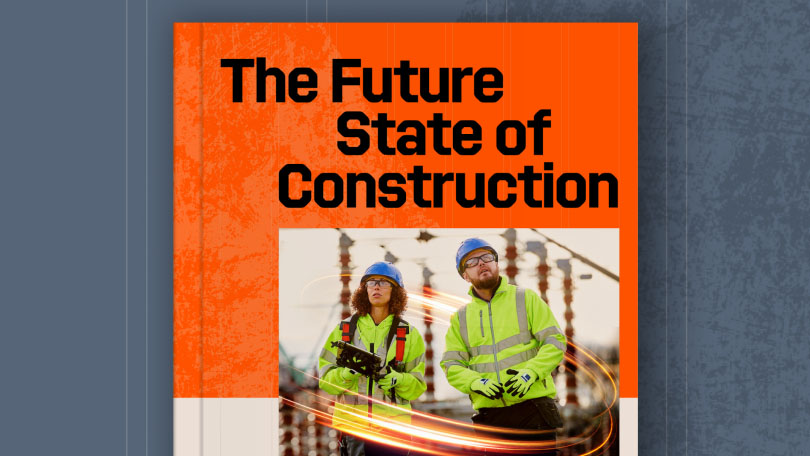— 14 min read
A Construction Expert’s Guide to the Bill of Quantities

Last Updated Oct 24, 2025

Jakir Hyder
Senior Sales and Solutions Consultant
Experienced construction engineer supporting the industry in digital transformation using experience and knowledge gained from Tier 1 contractor through customer focused and outcome based solution design during the presales process.

Nicholas Dunbar
Content Manager
62 articles
Nick Dunbar oversees the creation and management of UK and Ireland educational content at Procore. Previously, he worked as a sustainability writer at the Building Research Establishment and served as a sustainability consultant within the built environment sector. Nick holds degrees in industrial sustainability and environmental sciences and lives in Camden, London.
Last Updated Oct 24, 2025

A Bill of Quantities (BoQ) is a precise list of all the materials, labour, and construction equipment needed for a project, with quantities and descriptions used for cost estimation and overall project management. It’s like a shopping list for a construction project, with the type, amount and price of each material that a company needs to purchase to be able to build something. It also details the specific labour types and costs for carrying out the building work. Some people also call it a Bill of Materials, but BoQ is more common.
Table of contents
Key Components of the BoQ
There are four key components of a standard BoQ. These are:
- Item descriptions: Clear, specific descriptions of each component or task needed
- Quantities: Exact amounts or measurements of each item, e.g. m2, m3, etc
- Unit rates: The cost per unit of each item, based on historical data or current market prices
- Total costs: The overall cost of each item or labour type, calculated by multiplying the quantity by the rate of a single unit.
BoQ vs BoM - What’s the Difference?
In construction we use a Bill of Quantities; in manufacturing and supply-chain circles the comparable document is a Bill of Materials (BoM). The two look similar at first glance - both are itemised lists - but they serve different purposes:
A BoQ is built around the specific measurements of a building project. Alongside every material you will find the labour and, often, the major plant or equipment needed to install it. Because each line carries its own unit rate, the BoQ becomes the commercial backbone of the tender, the contract and every valuation that follows.
A BoM, by contrast, belongs to the world of product manufacturing. It lists every raw material, part and sub-assembly that goes into making a product, often arranged in a hierarchy from finished item down to the smallest screw. A BoM rarely includes labour hours or site equipment, and it is used primarily for procurement and production planning rather than for pricing tenders or valuing variations.
A BoQ is the construction industry’s cost-focused schedule of work, while a BoM is the manufacturing sector’s recipe for putting a product together.
What’s Included in a Bill of Quantities
- Materials - every item of concrete, steel, fixtures, etc.
- Labour - each trade category with hours or days required.
- Equipment (Plant) - cranes, scaffolding, pumps, and other plant, with hire periods.
- Quantities - the measured amount of each item (m, m², m³, hrs, days).
- Descriptions - clear wording so every party knows exactly what is being priced.
- Units of Measurement - the unit attached to each quantity (kg, m³, day, lump-sum, etc.).
Why is the BoQ important?
A BoQ is an essential document in the pre-construction phase because it accounts for every single item that a project team needs to complete a build. BoQs are usually prepared as part of the tender documentation that construction companies and subcontractors issue to suppliers so they can obtain and agree on a price for materials.
Why BoQs Deliver Real Value
Because a BoQ itemises every material, labour category and item of construction equipment, complete with quantities, descriptions and units of measure, it enables seven important benefits:
- Accurate cost estimation - the quantified list lets estimators price each unit precisely, producing reliable totals.
- Efficient tender preparation - bidders copy the BoQ schedule, fill in rates and return comparable bids, saving time.
- Managing variations - when the scope changes, only the affected line items are re-measured and priced, keeping change-order negotiations transparent.
- Improved cost control - site teams can track actual usage against BoQ allowances to spot overruns early.
- Minimised disputes - clear quantities and pre-agreed rates reduce arguments over what was included and how much is owed.
- Streamlined project management - the BoQ doubles as a task checklist, helping planners schedule resources and monitor progress.
Here are four reasons that BoQs are important:
Standardisation in Tendering
A Bill of Quantities allows a company to ensure standardisation, or uniformity, in the tendering process. This helps them to compare bids with accuracy and confidence. It also helps everyone involved in a construction project to stay on the same page, improving levels of understanding, collaboration and transparency.
Ensures Fair Pricing
A detailed BoQ helps to reduce the guesswork that can hold a project back. In particular, it
helps with fairness and accuracy in price estimates. By providing details such as the market price, it helps enable honest and evidence-based negotiations so that a client and construction company can agree on prices.
Aids Tender Analysis
A BoQ simplifies tender analysis, which is the process of evaluating and comparing bids. When a client receives a Bill of Quantities with a bid for a project, they can compare the costs of different bids with ease. This helps them to choose the best value for their project without sacrificing quality.
Compliance
By providing a list of the exact materials, items and specifications, the Bill of Quantities can help contractors to stick to project requirements. It helps keep everything consistent and makes it easier to check if contractors are using compliant methods and materials.
Learn about the future of the built environment - Read Procore's Future State of Construction report
Learn how contractors, subcontractors, and project teams can take advantage of new opportunities to boost efficiency and profitability over the next decade. Download the report to get your roadmap to the future state of construction.

The Benefits of Using a BoQ During Construction
Creating and using a Bill of Quantities helps to speed up processes and reduce guesswork before and during construction. Here are some of the areas that benefit from a BoQ:
Contract Sum Agreement
A BoQ makes it clear what the final contract sum is, and how the bidder arrived at that figure. Defining these costs and showing how each line item adds up to the final sum helps to show the sum of the different parts to a client. This reduces the need to explain or justify the final contract sum, as it is explained in the BoQ. This means there are no surprises down the line, too, which helps with client satisfaction and keeping a good reputation.
Schedule of Rates
A schedule of rates is a list of the pre-determined prices for materials and labour costs of a construction project. The schedule of rates informs the cost price on the Bill of Quantities. When companies use both documents together, they can get accurate estimates thanks to standardised pricing.
Interim Valuations
BoQs also help with interim valuations, which are essentially a progress check on the work. Interim valuations calculate how much a client owes a construction company based on the work that has been completed. The Quantity Surveyor can calculate how much a part of a project is worth using the costs and materials listed in the BoQ, based on the quantity of materials, the hours of labour, and the price of each of these.
Final Account Preparation
When it’s time to settle accounts and work out final payments, the Bill of Quantities simplifies the preparation of the final account, helping all parties to agree on what they have delivered, and the associated costs. Having the detailed list of all the materials used and the respective prices means there’s little room for debate: the costs are already outlined.
Contract Administration
The BoQ does far more than set the opening price; it remains the commercial measuring-stick throughout the contract. During construction, quantity surveyors rely on the agreed BoQ when they certify interim valuations, assess retention, and issue payment certificates. Because every material, labour category and item of plant carries its own pre-agreed rate, the site team can value completed work line by line, leaving little room for ambiguity. When practical completion approaches, the same schedule becomes the checklist for preparing the final account, helping both client and contractor verify that every measured item has been delivered and paid for. In short, the BoQ shows the entire life-cycle of contract administration - from the first shovel in the ground to the last sign-off.
Managing Variations
Changes are inevitable on most projects, but a detailed BoQ turns potential chaos into a manageable process. Suppose a design revision adds 120 m² of partition wall. Instead of renegotiating the whole contract, the parties simply return to the relevant BoQ line: “Lightweight stud partition, supply and fix - £48 / m².” By multiplying the existing rate by the extra quantity, they arrive at a transparent, evidence-based cost for the variation (£5,760), with no haggling over benchmarks or mark-ups. The same logic works in reverse when items are omitted. Because every variation is valued against the original BoQ rates, the project maintains cost consistency, reduces the risk of disputes, and keeps the audit trail clean for the final account.
What standards and methodologies inform the Bill of Quantities?
In the UK, there are standards that offer a commonly used method to create a Bill of Quantities. They provide consistency and help companies use best practices. These include the Standard Method of Measurement 7th Edition (SMM7) and the New Rules of Measurement (NRM).
What is the SMM7?
Until 2013, the most commonly used standard for preparing a BoQ was the SMM7. The RICS published the SMM7 in 1988, and the first edition dates all the way back to 1922. It provided detailed information including classification tables and instructions for how to measure building works. This ensured that everything was measured in a consistent manner so costs could be calculated accurately based on units in the BoQ.
What are the New Rules of Measurement?
The New Rules of Measurement were also published by the RICS, almost 100 years after the first edition of the SMM. The RICS published the NRM 1 in 2009, and the latest update, the NRM 3, in 2014. They replace the SMM7, as many industry professionals began to see the SMM7 as outdated for the modern industry.
There are many similarities between the SMM7 and the NRM. However, the NRM allows extra flexibility and the inclusion of smaller items that were not covered by the SMM7. There are also clearer definitions and guidelines for costs, provisional works and allowances for risk. The NRM is also more compatible with Building Information Modelling.
Preparing a BoQ
Preparing a Bill of Quantities needs close attention to detail and collaboration between different people involved in the pre-construction phase:
Design Stage
The design stage is where the BoQ’s journey begins. At this early phase in the construction process, architects and engineers work together to translate a design into plans and drawings. This sets the stage for the next phase, which is called ‘taking off’.
Taking Off Process
The taking off process is where the plans written down in the form of drawings become actionable data. It’s where you extract the exact quantities and measurements from the drawings so you can evaluate how much of each material is needed. With these numbers extracted, it’s then ready to be formatted into an approximate BoQ.
Approximate BoQ
An approximate BoQ is exactly what it sounds like: an early estimation which provides a rough but close estimate of how much a project will cost. It helps to set expectations and give everyone an idea of the quantities and costs of materials, and even the projected profits of a build. This is then developed by subcontractors, who take this approximate BoQ and develop it line by line for their needs.
Next Steps in Creating a Bill of Quantities
Once the initial quantities have been taken off, the estimator follows a few essential steps to turn those raw numbers into a finished BoQ:
- Structure and classification – group each item under the relevant work section and code it using the NRM or SMM7 rules so that everyone can find information quickly.
- Assign units of measure – decide whether each line is priced per metre, square metre, cubic metre, hour, day, or lump sum, and record that unit next to the quantity.
- Apply unit rates – research current market prices or draw on company cost-data libraries to add a realistic rate to every line item.
- Build subtotal and summary pages – let the spreadsheet or software roll the line totals up into work-package subtotals and, finally, the grand total.
- Quality-check and peer review – a second quantity surveyor checks the arithmetic, units, and compliance with the chosen measurement standard before the document is issued.
- Final sign-off – the cost consultant or commercial manager approves the BoQ so it can be included in the tender pack or contractual documents.
How BoQs Are Used in the Tender Stage
Once the approximate BoQ is in place, a quantity surveyor or cost consultant develops it into the formal Bill of Quantities that forms part of the tender documentation. This fully itemised schedule is then issued to prospective contractors, who simply add their unit rates against the common list of materials, labour and equipment.
Because every bidder is pricing exactly the same quantified scope, the client can compare tenders side by side with confidence, identify any anomalies, and select the most competitive offer without worrying that something has been left out or counted twice.
In this way, the BoQ not only streamlines bid preparation for contractors but also cements a fair and transparent tender evaluation process.
The Evolution of the BoQ
BoQs have come a long way over the last century. Traditionally, BoQs were painstakingly written and worked out by hand (with lots of crossing or rubbing out). Experts created them, as a BoQ needed a high level of precision and experience so that they were accurate and efficient.
As modern technology evolved, construction companies started to use digital technology to speed up the process of creating BoQs. Solutions like Microsoft Excel became more commonplace, and made it easier to create and share BoQs. But Excel is no longer the innovative new solution it once was. Today, integrated construction platforms include the functionality to create BoQs with templates, making the process more painless and efficient.
Who is in charge of preparing the BoQ?
A qualified quantity surveyor or cost consultant usually compiles the BoQ, although in smaller firms a single estimator may cover the task while larger contractors have a dedicated commercial team.
Challenges in Preparing BoQs
Even with all the advancements, sometimes there are still challenges with creating BoQs. Here are some of the common BoQ issues regularly facing construction professionals:
- Inaccurate or inconsistent data/measurements
- Human error
- Outdated information
- Difficulty accessing the right documents
- Inclusion of unnecessary items
How do BoQs enhance coordination?
BoQs help to enhance coordination by enabling better collaboration between individuals and teams in a construction project. The BoQ gives everybody a complete overview of what is needed in order to successfully complete work. This helps to create a shared understanding of requirements, is a good reference point when communicating about a project phase, and helps to keep people accountable for their part in a project.
Free Download
Bill of Quantities Template
Many construction professionals in charge of creating a Bill of Quantities use templates such as this to make the process more efficient and simple. They use common data processing computer programmes for organising and calculation, removing some of the problems associated with human error.
- Free starter template
- Ready-to-use
- Trusted by construction professionals


Future Trends
Emerging technologies are changing construction all the time. We’ve seen the rise of practices such as BIM become more common, and in turn create a more efficient work life for construction professionals. In terms of BoQs, it’s likely that artificial intelligence will soon find new efficiencies and speed up the process further. Automation is already helping to break down line items in the BoQ. Generative AI could take it to the next level, filling out information based on company or industry data.
How Construction Management Software Can Help
Construction management software can make the BoQ process much easier and quicker. It can automate the measurement and tracking of quantities from drawings, which reduces the risk of human error such as typos or misreading quantities. It can also perform cost estimates at the click of a button, as well as other kinds of calculations you might need.
Software provides a single source of truth which is up to date, by making sure that everyone is accessing and editing the same documents, and that users can amend them in real time. To stop things from getting out of control, software administrators can grant different levels of access and editing rights so that some people can only view the document while others are able to make changes.
Categories:
Written by

Jakir Hyder
Senior Sales and Solutions Consultant | Oracle
Experienced construction engineer supporting the industry in digital transformation using experience and knowledge gained from Tier 1 contractor through customer focused and outcome based solution design during the presales process.
View profileReviewed by

Nicholas Dunbar
Content Manager | Procore
62 articles
Nick Dunbar oversees the creation and management of UK and Ireland educational content at Procore. Previously, he worked as a sustainability writer at the Building Research Establishment and served as a sustainability consultant within the built environment sector. Nick holds degrees in industrial sustainability and environmental sciences and lives in Camden, London.
View profileExplore more helpful resources

Control the Chaos: Standardising Document Workflows in Construction Projects
Document control and implementation play a central role in managing risk, meeting deadlines, and delivering projects to spec. As builds become more complex and teams increasingly disperse, the volume and...

Cost-Plus Construction Contracts in the UK
A construction cost-plus contract – sometimes called a cost-reimbursable or prime cost contract – reimburses all project costs and adds a fee to cover the contractor’s overhead and profit. UK...

Digital Construction Technology for Whole-Life Value
For decades, the construction industry has kept a narrow focus on capital cost — the one-time, upfront costs of a construction project. While in the short term this seems like...

UK Construction Progress Reports: Tools for Smarter Site Management
Construction progress reports track completed work, on site issues, costs, and safety so UK project teams can demonstrate progress, secure payments, and stay on programme. Accurate progress data is essential...
